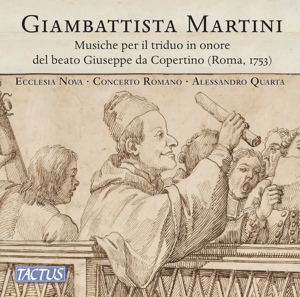
Giambattista Martini (1706-1784)
Musiche per il triduo in onore del beato Giuseppe da Copertino (Roma, 1753)
Domine ad adiuvandum
Ludate Dominum omnes gentes
Magnificat
Giuseppe Torelli (1658-1709)
Sonata in D major for trumpet and orchestra, G.1
Giambattista Martini
Te Deum
Ecclesia Nova
Concerto Romano/Alessandro Quarta
rec. live, 21 April 2023, Basilica di S. Francesco, Bologna, Italy
Texts online
Tactus TC701308 [42]
Giambattista, or Giovanni Battista, Martini – or even ‘Padre’ Martini as history came to know him better – is far more remembered now as a teacher and historian than for any of his compositions. The Mozarts corresponded with him, and the teenage Wolfgang received lessons during his Italian tours, composing the Miserere, K85, and the antiphon Quaerite primum regnum Dei, K86 as contrapuntal exercises under his guidance. I, for one, have never heard any of Martini’s compositions so this disc offers a welcome chance to encounter his technical skills put into practice. It comprises a selection of liturgical works he presented for the series of services that took place at Rome in 1753 for the beatification of Joseph of Cupertino, an early 17th century Franciscan mystic. As the title of this release indicates, there was a triduum or set of three vesper services in his honour, and as a Franciscan friar himself, Martini was called upon to provide the music – although he was a member of the order in Bologna, that city formed part of the Papal States at that time.
Scholarly notes by Elisabetta Pasquini, of the University of Bologna, set out the background as to how Martini drew together the compositions required, some newly written for the occasion, others adapted from pre-existing works. Her researches show how even this acknowledged master of composition sought advice from a musician friend, Girolamo Chiti in Rome, as to the modern techniques and liturgical customs expected by the authorities in that city. Despite that uncertainty and his reputation for pedagogical scrupulousness, Martini’s settings here display an affable, confident grasp of the up to date galant idiom and which, particularly in the Magnificat, is judiciously integrated with the older compositional style that he was more familiar with. The booklet cover, incidentally, reproduces a drawing of Martini at Rome conducting the very music he assembled for these religious festivities, by Pier Leone Ghezzi, also remembered for his famous caricature drawing of Vivaldi.
The live performance captured here, under Alessandro Quarta’s direction in the Bolognese church of which Martini was maestro, lends the music much ceremonial splendour. It exploits the building’s generous acoustic, so that Concerto Romano’s glowing trumpets and resonant timpani in the Domine ad adiuvandum and the Te Deum settings add gravitas. That sonic atmosphere also tends to emphasise the cello and double bass line of the basso continuo, frequently written by Martini in a continuously meandering movement, giving the music a sense of restless vigour.
The Ecclesia Nova chorus are somewhat recessed, and in the bustling first section of Domine ad adiuvandum, the sustained notes in the echo make the music sound even busier and multi-layered than it actually is. Otherwise the choral lines remain more or less clear and lithe, even in the more contrapuntal and extrovert sections of those works. But it is the more monolithic, chordal passages that come off best, such as the solemn opening of the C minor Magnificat, not unlike Vivaldi’s earlier setting in dramatic effect. A more disembodied approach by Ecclesia Nova in the section on ‘Et misericordia eius’ is just as effective, rendering the garish emphases on a couple of its suspensions rather unnecessary. The vocal solos are well characterised, the ‘Gloria patri’ section of Domine ad adiuvandum standing out in Giulia Bolcato’s brightly sustained melismas, and a fruity baritone contribution from Mauro Borgiani in the ‘Te gloriosus Apostolorum chorus’ movement of the Te Deum.
Martini’s works are interspersed with vocal intonations of relevant liturgical texts, not in plainsong settings but as embellished monodies with organ accompaniment in a style contemporary with him, but not credited here to any composer. The performance includes a stately interpretation of a Sonata for trumpet and orchestra by Torelli, the solo part given dignified resplendence, though there is also an expressive violin obbligato in the Grave third movement. The inclusion here of such an instrumental work from an older generation seems to be due to the fact that Chiti deplored the modern ‘noisy’ sinfonias that were used in liturgical performances, but regarded favourably the earlier works by Torelli and Corelli. The whole programme offers a usual snapshot of liturgical practice in mid-18th century Rome, and it is a pity that more of Martini’s settings weren’t included.
Curtis Rogers
Help us financially by purchasing from




















